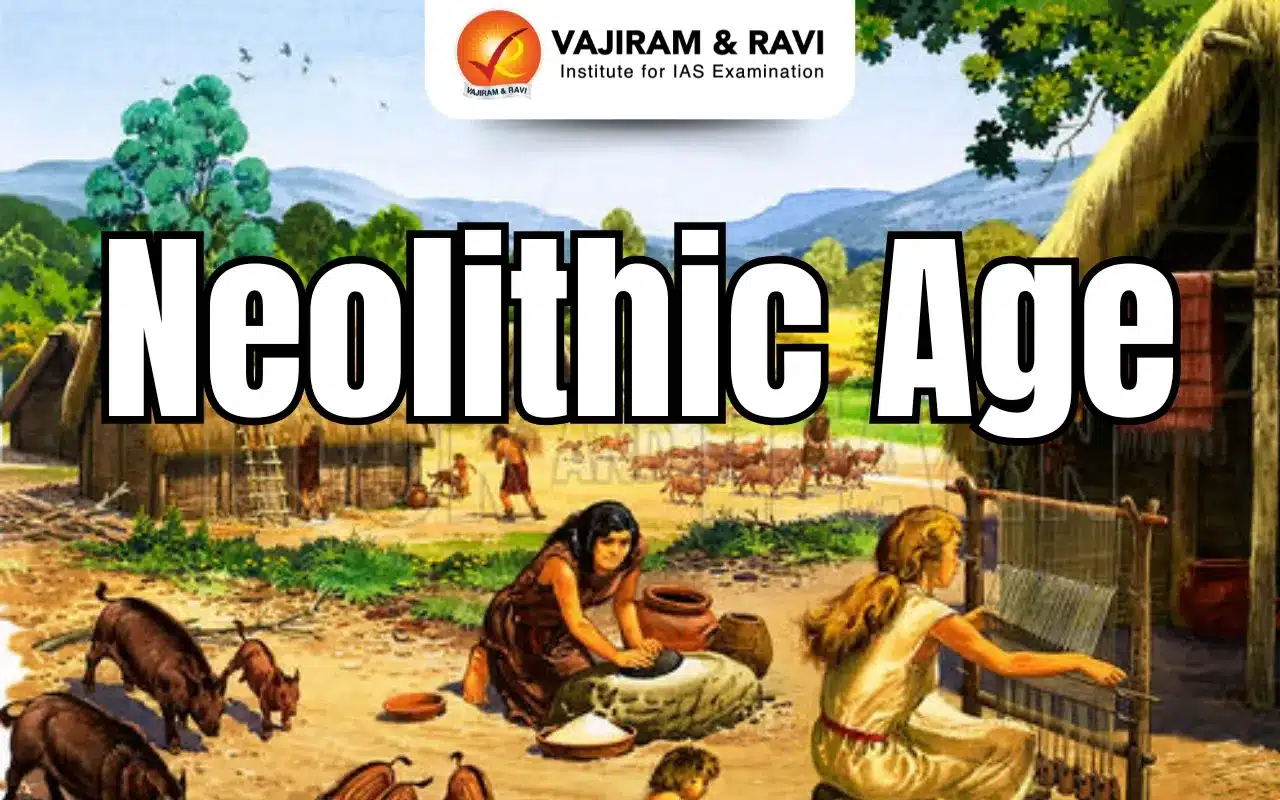Neolithic Age Latest News
The Archaeological Survey of India recently discovered one of the first rock grooves in Kanniyakumari district, which was created during the neolithic age, where people used to sharpen their weapons.
About Neolithic Age
- The Neolithic Period, also called the New Stone Age, is the final stage of cultural evolution or technological development among prehistoric humans.
- It is characterized by the beginning of a settled human lifestyle. People learned to cultivate plants and domesticate animals for food, rather than rely solely on hunting and gathering.
- The Neolithic stage of development was attained during the Holocene Epoch (the last 11,700 years of Earth’s history).
- The starting point of the Neolithic is generally thought to have occurred sometime around 10,000 BCE.
- The Neolithic followed the Paleolithic Period, or the age of chipped-stone tools, and preceded the Bronze Age, or the early period of metal tools.
- The Neolithic Revolution started in the Fertile Crescent, a region of the Middle East, where humans first took up farming. It then spread to India, Europe, and beyond.
Features of the Neolithic Age
- It was characterized by stone tools shaped by polishing or grinding, dependence on domesticated plants or animals, settlement in permanent villages, and the appearance of such crafts as pottery and weaving.
- The houses were built of mud and reed in rectangular or circular shapes.
- Alcohol was first produced during this period, and architecture, as well as its interior and exterior decoration, first appeared.
- Status objects like elaborate pottery and carved jades were placed in tombs during the Neolithic period. This practice suggests two things: Neolithic people’s belief in the afterlife and the emergence of social classes. Only important and wealthy individuals had the privilege of being buried with these precious objects.
Effects of the Neolithic Revolution
- The Neolithic Revolution led to masses of people establishing permanent settlements supported by farming and agriculture.
- It paved the way for the innovations of the ensuing Bronze Age and Iron Age, when advancements in creating tools for farming, wars, and art swept the world and brought civilizations together through trade and conquest.
End of the Neolithic Age
- Towards the end of the Neolithic era, copper metallurgy is introduced, which marks a transition period to the Bronze Age, sometimes referred to as the Chalcolithic or Eneolithic Era.
- In time, bronze became the primary material for tools and weapons, and a good part of the stone technology became obsolete, signalling the end of the Neolithic and thus of the Stone Age.
Neolithic Sites in India
Some of the important Neolithic sites in India include Burzahom in Kashmir, Chiron in Bihar and Uttar in Andhra Pradesh, and Edakkal caves in Kerala.
Neolithic Age FAQs
Q1. What is the Neolithic Age period?
Ans. The Neolithic Period, also called the New Stone Age, is the final stage of cultural evolution or technological development among prehistoric humans.
Q2. What is the difference between Paleolithic and Neolithic Age?
Ans. The Paleolithic Age was characterized by a nomadic, hunting-gathering lifestyle while the Neolithic Age marked a shift to settled agriculture.
Q3. The Neolithic Revolution first started in which region?
Ans. The Neolithic Revolution started in the Fertile Crescent, a region of the Middle East, where humans first took up farming.
Source: TH
Last updated on December, 2025
→ Check out the latest UPSC Syllabus 2026 here.
→ Join Vajiram & Ravi’s Interview Guidance Programme for expert help to crack your final UPSC stage.
→ UPSC Mains Result 2025 is now out.
→ UPSC Notification 2026 is scheduled to be released on January 14, 2026.
→ UPSC Calendar 2026 is released on 15th May, 2025.
→ The UPSC Vacancy 2025 were released 1129, out of which 979 were for UPSC CSE and remaining 150 are for UPSC IFoS.
→ UPSC Prelims 2026 will be conducted on 24th May, 2026 & UPSC Mains 2026 will be conducted on 21st August 2026.
→ The UPSC Selection Process is of 3 stages-Prelims, Mains and Interview.
→ UPSC Result 2024 is released with latest UPSC Marksheet 2024. Check Now!
→ UPSC Prelims Result 2025 is out now for the CSE held on 25 May 2025.
→ UPSC Toppers List 2024 is released now. Shakti Dubey is UPSC AIR 1 2024 Topper.
→ UPSC Prelims Question Paper 2025 and Unofficial Prelims Answer Key 2025 are available now.
→ UPSC Mains Question Paper 2025 is out for Essay, GS 1, 2, 3 & GS 4.
→ UPSC Mains Indian Language Question Paper 2025 is now out.
→ UPSC Mains Optional Question Paper 2025 is now out.
→ Also check Best IAS Coaching in Delhi
Tags: neolithic age prelims pointers upsc current affairs upsc prelims current affairs

















